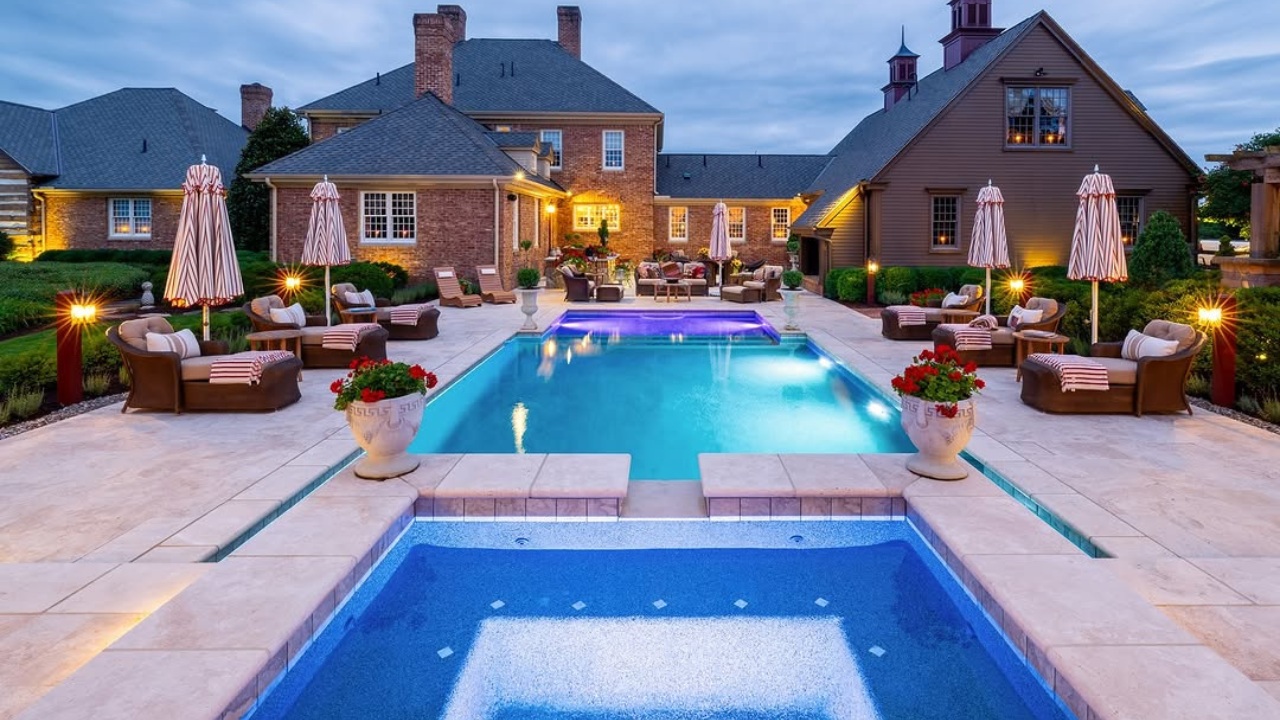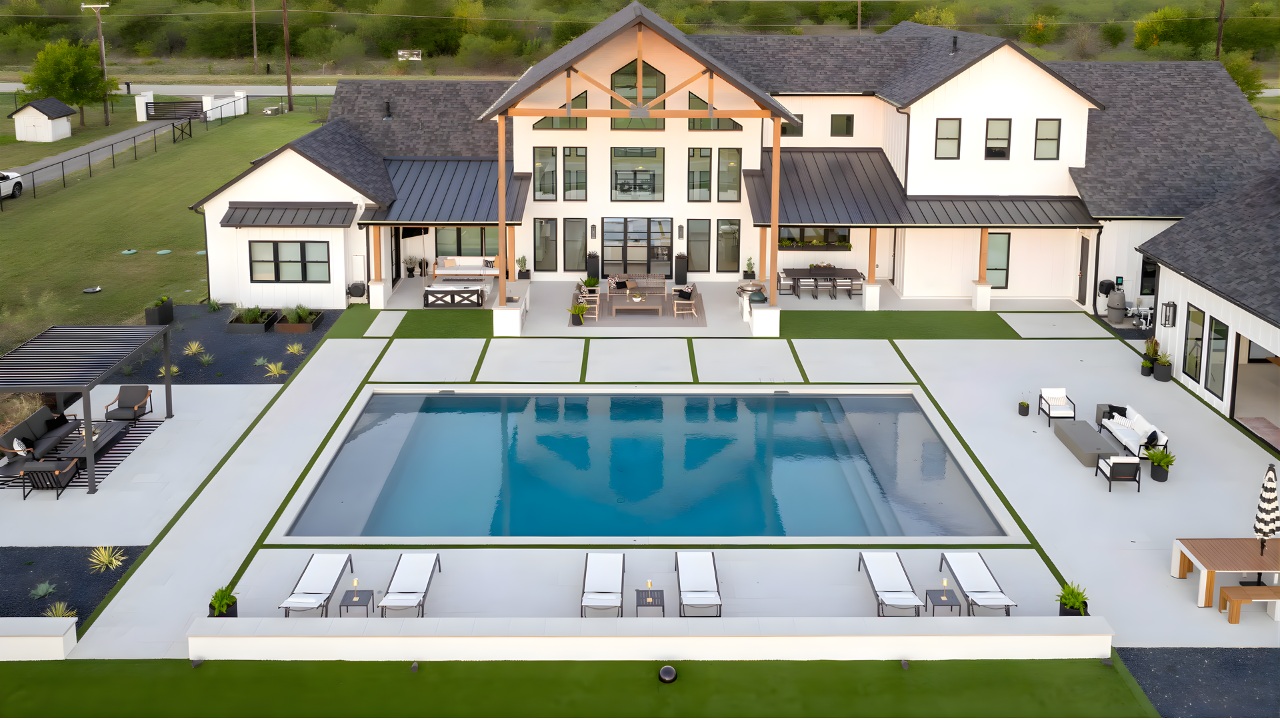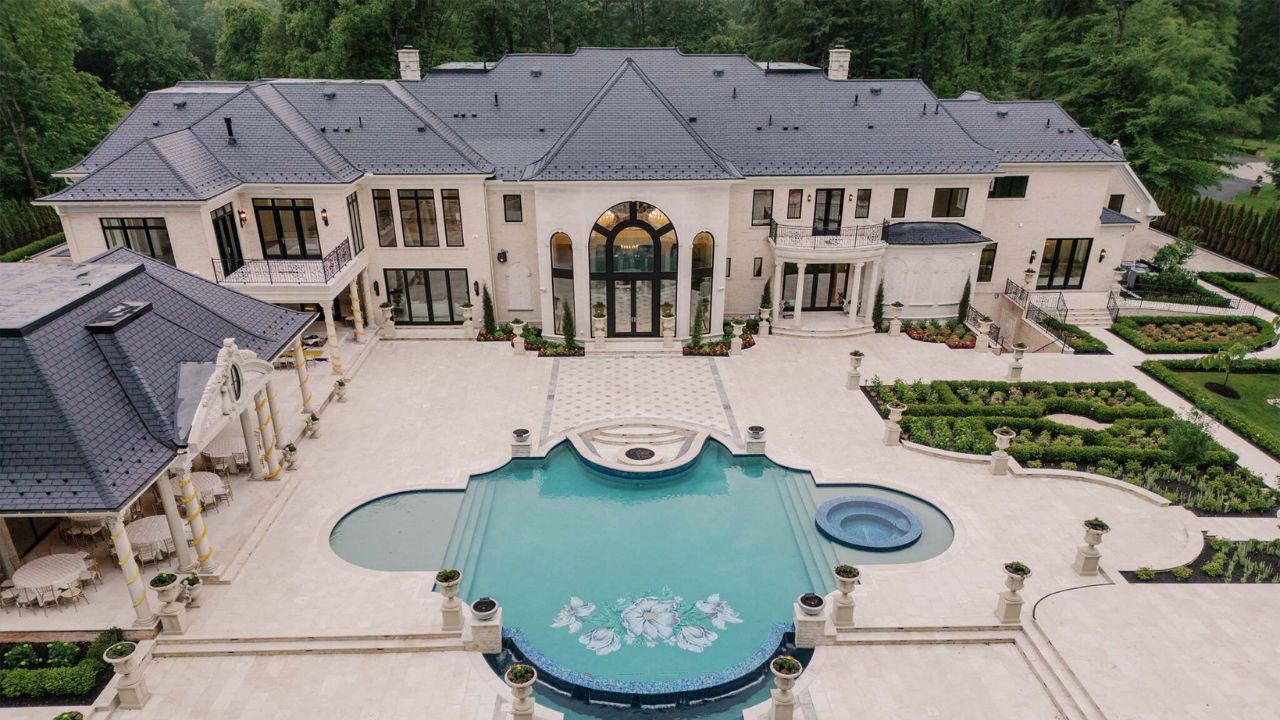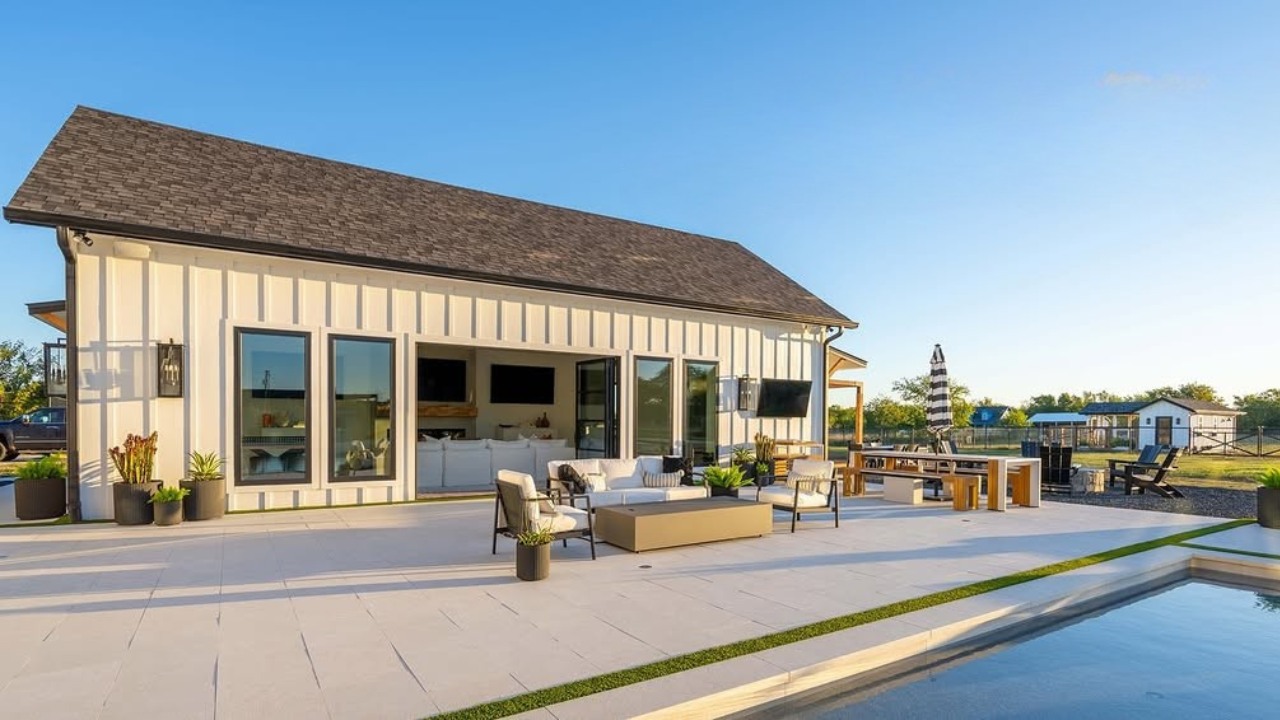Porcelain tile surfaces are available in various types of finishes compared to natural materials. Each finish is designed to serve a specific purpose. such as smooth finish hides stain better, while a matte surface offers high slip resistance. This is why homeowners often feel unsure about which finish of this ceramic tile type to choose from due to the wide range of surfaces available. So, we will explain different types of porcelain surface finishes to give you a better idea. Continue reading the following.
What Are the Different Types of Porcelain Tile Surface Finishes?
The differences in each type may seem subtle, but they matter. In the following table, we highlighted the 10 primary types of porcelain tile finishes, features, and applications. This table has complete information, so you can conveniently understand every surface.
| Finish Type | Appearance | Slip Resistance | Maintenance | Best Used In |
| Polished | High-gloss, mirror-like | Low (slippery when wet) | Easy to clean, shows spots | Living rooms, formal spaces |
| Matte | Dull, non-reflective | High | Hides smudges and water | Bathrooms, kitchens, and mudrooms |
| Glazed | Colorful, patterned, glassy layer | Varies (based on glaze) | Very easy, no sealing needed | Walls, backsplashes, light-traffic floors |
| Unglazed | Earthy, natural, through-body color | Very high | May need sealing | Outdoor areas, commercial spaces |
| Textured | Ridges, grooves, tactile | Very high | Moderate, harder to mop | Pool decks, exterior walkways, rustic rooms |
| Lappato (Semi-Polished) | Soft sheen, subtle gloss | Moderate | Easy, balanced finish | Hallways, showrooms, and contemporary homes |
| Satin | Smooth, low-gloss glow | Moderate to high | Hides prints, easy to maintain | Kitchens, living rooms, and subtle luxury areas |
| Metallic | Industrial, reflective metal look | Low to moderate | Easy, but shows marks | Accent walls, modern lofts, boutique bathrooms |
| Natural | Slightly rough, stone-like texture | High | Minimal, very durable | Patios, balconies, garden paths |
| Bush-Hammered | Rugged, chipped texture | Very high | Low, but textured to clean | Pool surrounds, driveways, ramps |
This table simplifies the selection process for homeowners, designers, and contractors looking to choose the right porcelain tile finish based on function and aesthetics. Below, you will learn about each finish and where it works best.
1- Polished Porcelain Tile Finish
Polished porcelain tiles go through a grinding process and a buffing process that result in a shiny and reflective surface. These tiles offer a finish similar to natural marble that looks clean and has a luxurious look.
The smooth surface, like this “Brenta Marble Look Porcelain Slab,” is also non-porous. This is why it resists stains as well. However, the polished surface gets slippery when wet, so it is not a good choice in active areas with moisture, such as around pools or showers.
Best used in: Living rooms, hallways, and formal interiors.
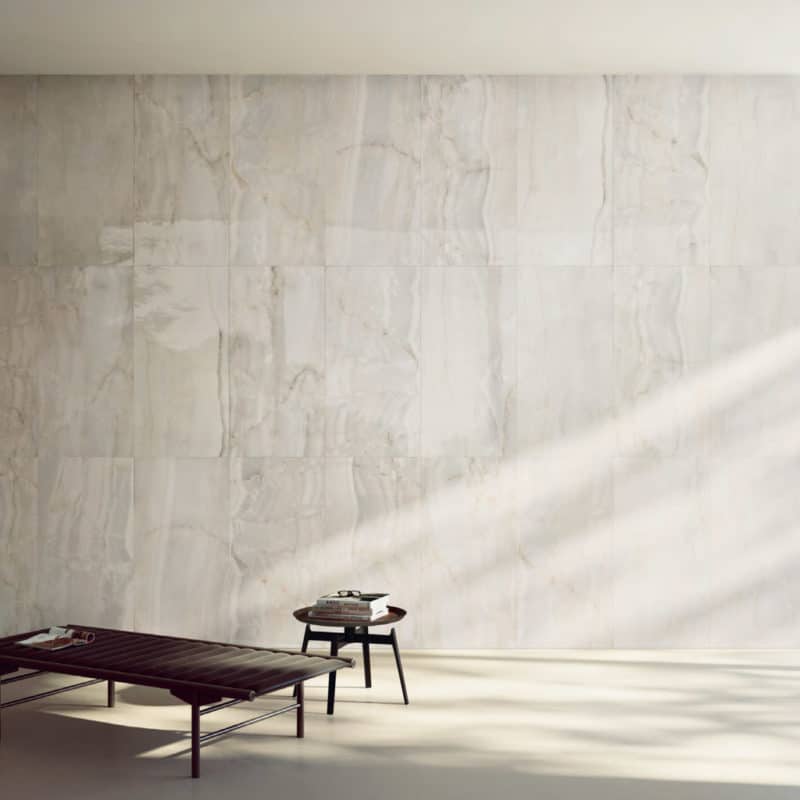
2- Matte Porcelain Tile Finish
Matte finish on porcelain tile features a non-reflective and dull surface. It feels soft under the foot and provides better slip resistance than polished tiles. This makes them a perfect choice for areas that are usually wet. The best thing about matte porcelain tile like this Titan Aluminum Matte Large Porcelain Slab is that it can hide water spots and smudges better. This means you will not have to clean too often.
Although matte tiles look subtle, they offer strong performance in areas like bathrooms, kitchens, and entryways.
Best used in: Bathrooms, kitchens, mudrooms.
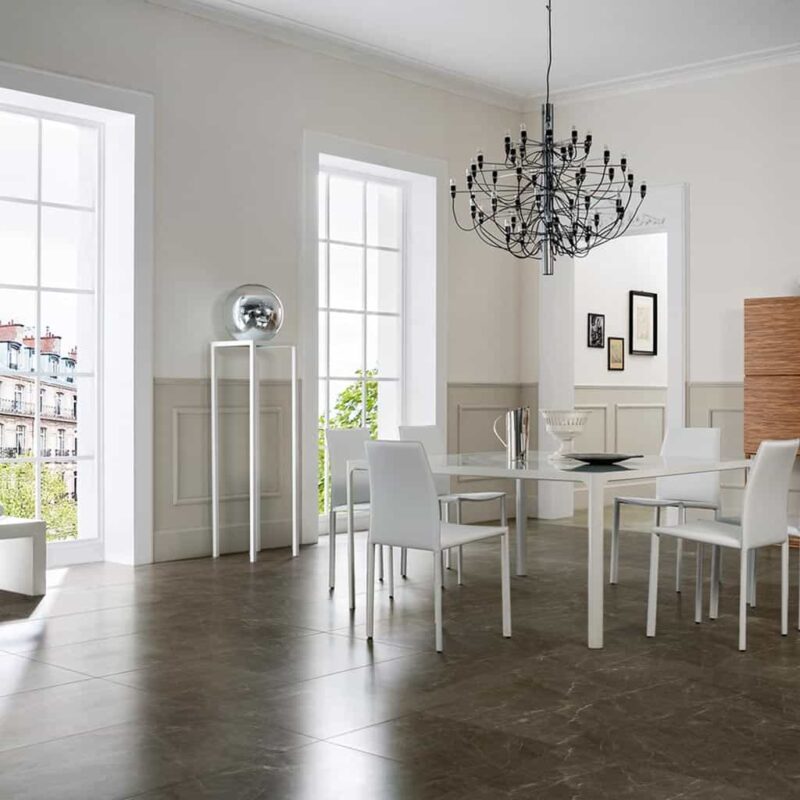
3- Glazed Porcelain Tile Finish
Glazed porcelain tile finish similar to this Nero Marquinia Porcelain Tile features a layer of liquid glass that is added during manufacturing. The layer can be of different types, from glossy, matte, or satin, depending on the preferred finish. This adds the color, pattern, and extra protection to the tile.
The glazed porcelain finish makes it stain and moisture-resistant. Glazed porcelain tiles are also easier to clean, but they can show signs of wear and tear more visibly in high-traffic zones.
Best used in: Walls, backsplashes, and low-traffic floors.
4- Unglazed Porcelain Tile Finish
Unglazed porcelain tile or slabs like this Titan Aluminum Matte Porcelain Slab don’t opt for glass coating and have a uniform surface throughout. This is why they are tough and long-lasting. Like this Flake Porcelain Pavers, this outdoor porcelain finish offers better grip and natural texture.
This finish is best suited for outdoors and commercial areas. They may require sealing to prevent staining.
Best used in: Patios, walkways, and commercial kitchens.
5- Textured Porcelain Tile Finish
Textured porcelain tile surfaces have ridges, bumps, or grooves pressed into the surface, i.e., Devon Dark Porcelain Slab. This gives the porcelain a natural stone or weed grain look.
A textured surface has intentional ridges, bumps, or grooves pressed into the surface. This mimics natural stone or wood grain.
The uneven texture improves traction and adds visual interest. These tiles work well where safety and style matter equally.
Best used in: Pool decks, outdoor paths, rustic interiors.

6- Lappato Porcelain Tile Finish
Lappato porcelain finish is the semi-polished tiles. They are the result of soft sheen and not shiny like polished tiles. However, they are still more reflective than the matte ones. The finish is a perfect balance between style and function.
You get some level of gloss but don’t sacrifice slip resistance.
Best used in: Open-concept interiors, hotel lobbies, transitional areas.
7- Satin Porcelain Tile Finish
The satin porcelain tile is a combination of matte and polished finishes. They have a smooth surface with a soft, low-sheen glow. This porcelain finish is preferred for its versatility.
They prevent fingerprints and provide better slip resistance, which makes them a safe and stylish middle ground.
Best used in: Kitchens, living rooms, and accent walls.
8- Metallic Finish Porcelain
Metallic porcelain tiles feature a special glaze that creates a metal-like appearance. Think bronze, steel, or copper. These tiles often show movement or reflect light differently depending on the angle.
They add a bold, contemporary edge to interiors. Due to their striking look, it’s best to use them as highlights, not the entire floor.
Best used in: Feature walls, modern lofts, upscale bathrooms.

9- Natural Porcelain Tile Finish
Natural finish tiles get minimal processing by manufacturers. Their surface resembles cut stone, slightly rough but not gritty.
This finish provides a grounded, earthy aesthetic. These tiles are highly slip-resistant and weather-friendly.
Best used in: Outdoor patios, balconies, garden paths.
10- Bush-Hammered Porcelain Tile Finish
Bush-hammered finishes use a mechanical process to chip away the tile’s surface slightly, creating a rugged texture.
These textured surface tiles boost slip resistance and create a raw, tactile feel. It’s ideal for safety-conscious outdoor applications, especially in wet zones.
Best used in: Pool edges, ramps, driveways.
How To Select The Right Porcelain Tile Surface?
Because of the different types of outdoor and indoor porcelain surfaces, selecting the right surface type can be overwhelming. The following table can help you learn the considerations for porcelain finishes for your project.
| Selection Factor | What to Consider | Best Finish Types | Why It Works |
| Indoor vs. Outdoor Use | Will the tile be installed inside or outside the home? | Outdoor: Textured, Natural, Bush-Hammered
Indoor: Matte, Polished, Glazed |
Outdoor finishes provide grip and weather resistance; indoor options offer style |
| Slip Resistance Needs | Will the surface be wet or exposed to moisture often (e.g., bathrooms, pools)? | Matte, Textured, Bush-Hammered, Natural | These finishes help reduce slip risks where safety is key |
| Foot Traffic Level | Is the area used daily by many people (e.g., hallways, kitchens)? | Lapatto, Satin, Unglazed, Textured | These finishes are durable and hold up under constant movement |
| Design Aesthetic | Are you aiming for modern shine or rustic charm? | Polished, Metallic, Glazed (modern)
Natural, Textured (rustic) |
Matches style preferences without compromising performance |
| Ease of Cleaning | Do you need a finish that hides dirt and cleans up easily? | Matte, Satin, Glazed | These surfaces resist smudging and are easy to wipe down |
| Maintenance Commitment | Are you okay with occasional sealing or do you prefer low-maintenance surfaces? | Low-maintenance: Glazed, Matte, Satin
More effort: Unglazed, Textured |
Some finishes may need sealing; others are ready to go with minimal upkeep |
| UV and Weather Exposure | Will the tile face direct sun or changing weather conditions? | Natural, Bush-Hammered, Unglazed | These resist fading, cracking, and weather stress |
| Application Type | Will the tile go on floors, walls, or vertical features? | Walls: Glazed, Metallic
Floors: Matte, Textured, Satin |
Each finish suits its place—slip resistance for floors, design for walls |
| Room Purpose | Is it a quiet, formal room or a high-energy space like a kitchen? | Formal: Polished, Lapatto
Busy: Matte, Natural |
Balances visual impact with function, based on how the room is used |
| Budget and Longevity | Are you seeking long-term durability with reasonable investment? | Unglazed, Matte, Natural | These last for decades and offer excellent long-term value |
Our expert tip is to match the tile finish to the intended use, lighting, and maintenance preference. For instance, porcelain tiles come with textured or matte finishes that are ideal for wet areas, and polished or satin finishes suit dry, decorative spaces.
FAQs Porcelain Tile Surface Finishes
Here are some of the most common questions about the surface of the tile.
What porcelain tile finish is best for outdoor patios?
Natural, textured, or bush-hammered finishes are the best choices for outdoor patios.
Can I use polished porcelain in kitchens?
Yes. But use with caution, as the polished porcelain surface doesn’t offer good slip resistance.
Do I need to seal unglazed porcelain tiles?
Yes. Unglazed porcelain tiles require sealing, too, but less often,
Which finish hides dirt the best?
Matte and satin finishes hide dirt better, including water spots and smudges.
Are all porcelain tile finishes equally durable?
No. Glazed layers may wear down in high-traffic spots, while unglazed and bush-hammered tiles are tougher for long-term use.
Conclusion
Porcelain comes in a variety of finishes, which is why choosing the right porcelain tile finish can be tricky sometimes. However, you can use Polished and High gloss for dry, elegant spaces, and Matte is perfect for bathrooms and kitchens. Glazed porcelain is ideal for walls and light-use floors, while the unglazed porcelain is tough, raw, and best for high-traffic or outdoor areas.
Whether you’re selecting the best tile for shower walls or planning a durable patio, consider choosing the right porcelain tile surface that meets your requirements. This is crucial for a lasting structure.
To learn more about matching surface finishes to your project needs, contact your tile provider or explore design ideas with a trusted supplier like NT Pavers for the best suggestions and premium products.


